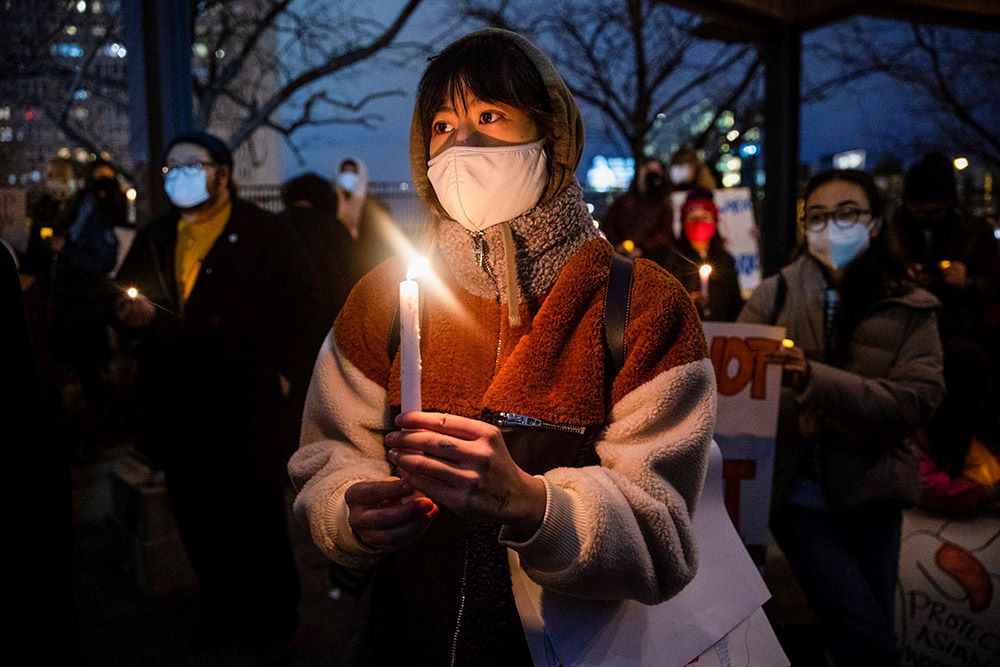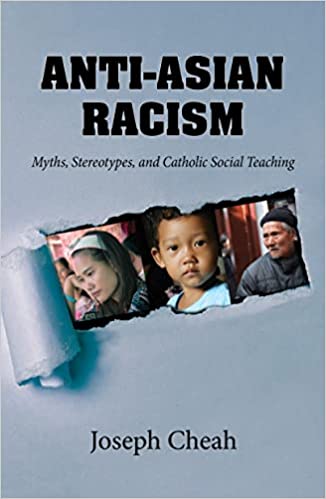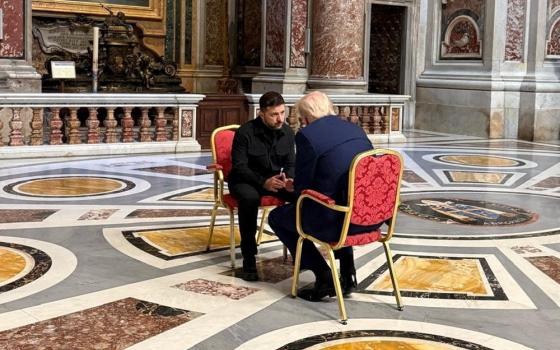
People in Philadelphia attend a vigil in solidarity with the Asian American community in 2021. (CNS/Reuters/Rachel Wisniewski)

Servite Fr. Joseph Cheah is hopeful that telling Asian American-centered stories will help communities and individuals begin to understand the ways in which racism and white supremacy have shaped history. In his latest book, Anti-Asian Racism: Myths, Stereotypes, and Catholic Social Teaching, Cheah takes a wide and integral view on how Catholic social teaching can inform the way Catholics engage in the work of anti-racism in the context of Asian American communities.
In a recent interview for NCR, writer Clarissa V. Aljentera spoke with Cheah about his research and writings. The interview has been edited for length and clarity.
NCR: The intersection of anti-Asian racism and Catholic social teaching is important to note, especially considering that the principles of Catholic social teaching don't explicitly name racism. How important was it for you to tell the story of racism from the lens of an Asian American?
Cheah: While Catholic social teaching doesn't explicitly name racism, it talks a great deal about the dignity of the human person and the church has the responsibility to protect the dignity of the human person through social ministry. It does that by surrounding each person with human rights and human responsibility. Each person has a right to live in an anti-racist society where the dignity of the human person is accepted and respected. Likewise, each person has an obligation to educate themselves, to examine their own thoughts and actions.
It's important to tell the story from the lens of Asian Americans because there is a myth that Asian Americans don't experience racism and discrimination – survey after survey has shown that most Americans believe this. However, in my book I cite a 2019 Pew study about race in America that reported that 76% of Asian Americans said they experienced a significant amount of discrimination — about the same amount as African Americans at 76% and Hispanic Americans at 58%.
It's important for us to tell our stories and experiences because our stories are gifts and contributions that are essential to what it means to be American in our country. And what it means to be an Asian American Catholic in our church in the United States.
The examples in this book of various myths regarding the Asian American community are among many stereotypes that exist in the world today. How did you decide to make those the focus of this book?
It's well known with those engaged in Asian American studies that the most destructive stereotypes are those of perpetual foreigner, yellow peril and model minority myth. Those three are well established in the academy. All Asian Americans experience at least one of those three myths. It's unavoidable and it's part and parcel of our experience.
The idea of the perpetual foreigner is that it doesn't matter how long you have been in the country – whether you were born here or your family came many generations ago – we've all been seen as foreigner. Most of us have experienced being asked where we are "really" from, that kind of stuff.
"Yellow peril" originated in the mid-19th century in Europe and is a myth about Asians being "uncivilized." The roots go back to Genghis Khan. It's this idea that Asians and Asian Americans are dangerous people and disease carriers. It engenders a fear that can often lead to Anti-Asian violence, especially during economic downturn. It also shows up during public health crises, like the COVID-19 pandemic. It comes and goes and has resurfaced in American history because we never really dealt with it. We never really dealt with the sin.
I'm curious to know if you, as an Asian American priest, have encountered stereotypes or racism in your own life? Or even within your vocation?
Some people think once you get ordained and get professed you somehow avoid all the racist stuff. But people who are in religious life and priesthood come from society. They carry the baggage with them and the stereotypes and racism with them. It's going to manifest itself within the priesthood; we're not somehow protected from that.
The kind of racism I have experienced is pretty tame compared to the kind I experienced growing up in a city neighborhood. The various apostolates in which I have ministered have been with people who, for the most part, have never and will never have their "Americanness" called into question. Their social location has shielded them from being considered as the "other," as a foreigner.
The predominant stereotype I have experienced in priesthood and religious life is one of perpetual foreigner. It shows up in different ways. The type of racism I experience is microaggressive, or a so-called casual experience. It ranges from the classic, "Where are you from? Where are you really from?" to assumptions or inferences of false history or facts about the entire Chinese population, generally without malicious intent but uncomfortable nonetheless.
Advertisement
The goal of solidarity between various groups of people of color and allies is a necessary answer to the work of anti-racism. What might solidarity look like in a parish, school or community?
There's a consensus among Asian American community organizers, activists and academics that solidarity is not only the best but may be the only way to address racial hatred and violence. During the recent surge of violence against Asian American elders in particular, the natural reaction from many community members in Chinatown and places like that is to say we need greater police protection. But Asian American community-based organizers caution against reliance on law enforcement, for fear that it might criminalize African Americans.
The community-based organizer may feel that the best way to protect the most vulnerable in a community is to get to the bottom of violence. And the best way to do that is to work in concert with other marginalized communities. Working together with another community of color works to solve the problem, and that reflects the best of the solidarity principle of Catholic social teaching.
In terms of school and parish level, solidarity is not achieved unless you allow people who are from a less privileged social location to talk. There must be a listening session to get to know each other.
In the parish setting if we could hear a homily talk about these things or give some reflection on these issues, it would be a start. There has to be a gathering of people for a listening session to really share where they are coming from in an atmosphere of trust and inclusion and desire to build community. Listening sessions will help build bridges and create a bond.
In the school setting, education is primary. Our standard, usual American history is not enough to form an anti-racist education. It must also include the pivotal history of the Black and white binary, as well as the ways in which ideology operated in the lives of Native Americans, Asian Americans, Latinx and other people of color.
How do you hope readers might respond to hearing and learning about the history of exclusion, racism and white supremacy that Asian Americans have faced within the Catholic Church?
I feel that you need to tell the truth, even if it hurts – especially about a group whose experiences of racism and discrimination have been ignored and dismissed. The pandemic has been a good time to talk about these things since a lot of community members are suffering. I did expect pushback about the book, but so far it's been encouraging. In one webinar interview I was asked whether I would rewrite the 2018 U.S. bishops' pastoral letter "Open Wide Our Hearts" to name the sinners if I had the chance. I basically told them I would name the system that Jim Wallis and James Cone call America's original sin, which is white supremacy.
If you don't talk about it, you aren't going to solve the problem. White supremacy is dangerous because it operates within many of our institutions. It's embedded within it. Many people aren't aware of it, and it's important to name and address it.





